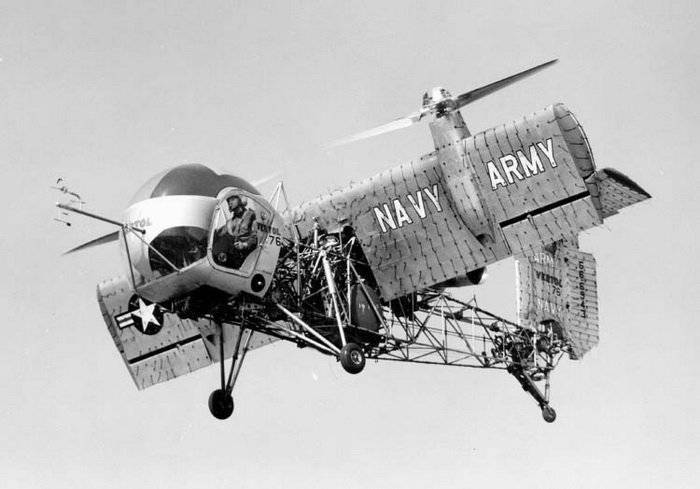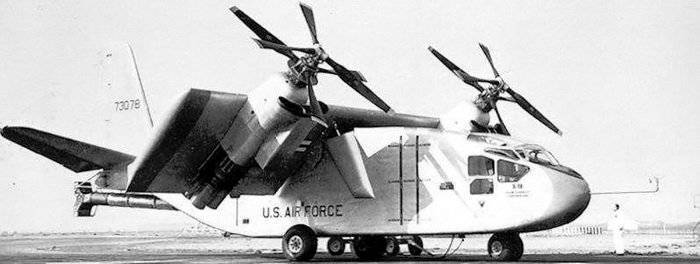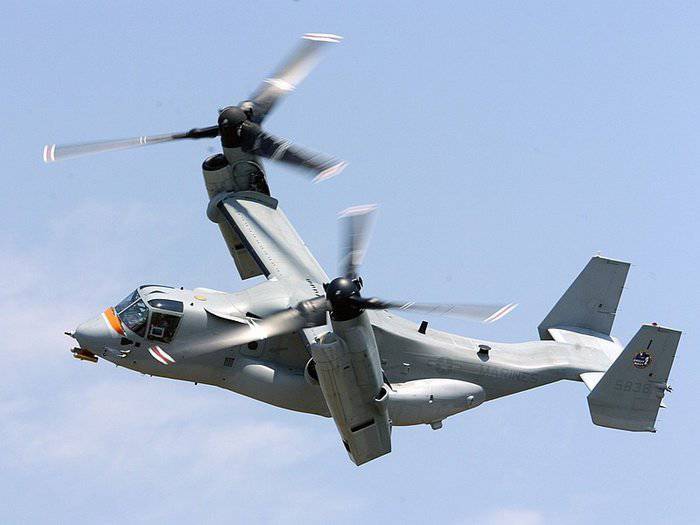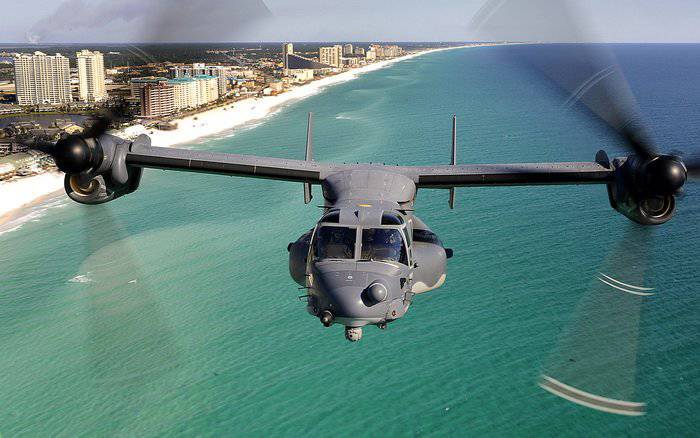Converting Flying Transformers
It is worth noting that dreams of building such an aircraft that would be able to make a vertical take-off and landing, simultaneously with high-speed horizontal flight, have equally long-standing historylike dreams of flying in general. The first projects of something similar offered at the time even Leonardo da Vinci. The very idea of “crossing” a fairly fast, but limited to the flight regimes and home conditions, and a much less speedy, but unpretentious helicopter at the take-off and landing sites, occupied the minds of designers and the military for many years. However, any significant development of such devices could be achieved only recently.
Work on convertiplanes - aircraft, which due to the rotation of propellers could be converted from a helicopter to an airplane and vice versa, was carried out in many countries of the world. Designers of almost all states with developed aviation industry, worked on such machines for more than half a century. The first works in this area can be attributed to the 1920-1930th years of the last century. They worked on the creation of a convertiplane in pre-war Europe, during the war they worked on a project of such machines in Germany. In the 1970s, work was carried out in the Mil Design Bureau on the project of the Mi-30 convertiplane, which did not fly up into the sky. As a result, certain successes in their creation were achieved only in the USA. The only Bell V-22 Osprey tiltrotor currently in serial production is in service with the US Marine Corps. Its development by Boeing and Bell took more than 30 years.

According to its own scheme, convertoplanes can be divided into 2 basic classes, each of which is characterized by its own specificity and its characteristic problems of conversion and transmission of thrust developed by the power plant of the machine. We are talking about convertiplane with a swivel wing and convertiplane with rotary screws.
Aircraft with a rotary wing combine the characteristics of multi-engine aircraft, in which the engines are located on the wing consoles in a fixed position with the capabilities of vertically taking off and landing helicopters. This technical solution allows to achieve distances and flight speeds characteristic of the aircraft (also the possibilities for cargo transportation), together with the possibility of making a vertical takeoff and landing. During take-off, the wing of the apparatus data is set to a vertical position, and the propellers create the thrust necessary for the take-off of the car. During the transitional flight mode, the wing gradually returns to the horizontal position. After returning to the horizontal position, all the lifting force is created by the wing, and the propellers provide the thrust necessary for the horizontal movement of the vehicle.
At one time, a number of American aircraft manufacturing firms, as well as one Canadian company, experimented with similar devices, some of their experiments can be considered quite successful. For example, the American convertiplane with a swiveling wing X-18. The X-18 convertoplane had a rectangular-shaped fuselage and a high wing with a small span. In the middle part of the wing, 2 powerful Allen T40-A-14 turboprop engines were installed, which developed power in 5 500 hp. each. These engines were equipped with three-bladed turbo-electric propellers of opposite rotation “Curtis-Wright” (the diameter of the screws was 4,8 meter).

During the “helicopter” take-off, the entire wing of the convertible was turned together with the engines (around its longitudinal axis by 90 degrees). At the same time, the standard aircraft take-off was used to take off the device with a maximum load. In addition, in the tail end of the aircraft there was an additional Westinghouse J-34-WE turbojet engine, which developed thrust in 1530 kgf. His jet stream could change its direction in a vertical plane, which significantly improved the control of the convertoplane at low flight speeds.
In 1958, the first and, as it turned out, the only prototype X-18 was made. This tiltrotor passed a rather intensive cycle of ground tests, after which in the year 1959 was transferred to the Research Center. Langley, where 24 November, 1959, for the first time took to the air. Prior to the completion of flight tests in July 1961, the X-18 convertiplane managed to fly about 20 flights. The main reason for the end of his tests and the subsequent shutdown of the program was a malfunction in the mechanism for changing the propeller pitch that occurred during the last flight of the vehicle, as well as the fact that its engines "were not interconnected." During one of its further ground tests, the convertiplane X-18 was destroyed and ended its life in a landfill. However, it is worth noting that this convertiplane allowed us to collect a sufficient amount of data that was necessary for the construction of a heavier and more sophisticated convertible plane XC-142, which has 4 engines.
The second most common type of convertoplanes can be called a model with swivel screws. They are more widely used, at least among experimental aircraft for sure. The disadvantage of such models in comparison with classic helicopters is the need to have wings of a sufficiently large span. This is due to the fact that on such devices are often mounted near 2 sufficiently large screw diameter. This requires an increase in site, which is used to perform takeoff and landing. Since power plants consisting of several engines, which drive propellers, are used in the construction of many convertoplanes, the failure of one or several of them can be disastrous for the apparatus. With this in mind, in order to prevent a catastrophe in the design of multi-engine convertaplanes, it is often possible to find cross transmissions that allow you to drive several air screws from the 1 engine, which in turn leads to an increase in the mass of such vehicles.

It is worth noting that turning screws are usually not the screws themselves, but gondolas with them, as is the case on the Bell V-22 Osprey tweeter. This aircraft, which is in service with the US Marine Corps, is equipped with 2 X engines with Rolls-Royce T406 power in 6150 hp. each. The engines are located in special gondolas at the ends of the wing and can be rotated up to 98 degrees. Three-blade screws with trapezoidal blades are interconnected by a synchronizing shaft, which is laid inside the convertoplane wing. This shaft also allows the Bell V-22 Osprey to land only with the 1 running engine. In order to reduce the mass of the design of a convertoplane, about 70% of the apparatus is made of composite materials based on glass and carbon plastics with an epoxy binder, which makes its design 25% lighter than its metal counterpart.
Since this tiltrotor should be based on areas of limited size, it is equipped with folding wings and screws, which allows reducing its width on the ground to 5,51 meters. The crew consists of a 2 man, and an 24 paratrooper with his own weapon can be accommodated in his cargo bay. Convitoplane screws with a diameter of 11,6 meter to reduce weight are also made of fiberglass
With the wing extended, the width of the Bell V-22 Osprey at the tips of the blades is 25,78 meters. The length of its fuselage is the 17,48 meter. Machine height - 5,38 meters, with vertically mounted engines increases to 6,73 meters. The maximum take-off weight is slightly more than 27 tons, while the payload mass when using the vertical take-off is 5 445 kg. The weight of the load on the external sling is when using 2's 6 147 hooks kg. The maximum speed of the convertoplane in aircraft flight mode is 483 km / h, and in helicopter mode, 185 km / h. Practical range - 1627 km.

It should be noted that the only serial convertoplane is costly to the US budget, and the number of purchased machines is revised downwards over a number of years. Its prices range from 71 to 58 million dollars per unit. At one time, the senator John McCain, so much disliked by Russians, gave him the following description: the V-22 looks great in the sky ... when he is not idle for repairs.
Information sources:
-http://www.bratishka.ru/archiv/2012/09/2012_9_15.php
-http: //sw-master.narod.ru/fly_sh_3.htm
-http: //nvo.ng.ru/armament/2006-03-31/6_convertoplan.html
-http: //ru.wikipedia.org/wiki
Information